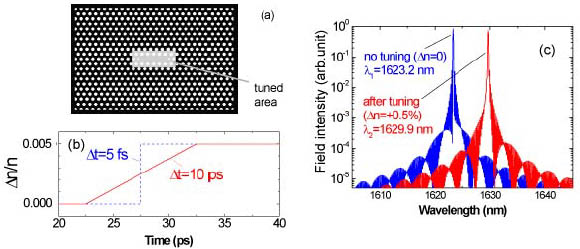Masaya Notomi
Optical Physics Laboratory
"Wavelength" is one of the most important characteristics of light, which has been employed in various optical technology, such as wavelength-demultiplexing communication. Though it is not so difficult to generate light with a particular wavelength using a tunable laser, it is not easy to change the wavelength after generated. Usually, we make use of high-order optically-induced electronic polarization in some special crystals to convert the wavelength. However, this nonlinear process requires high optical intensity. Very recently, we found that we can linearly convert the wavelength of light by a fundamentally different mechanism.
This novel conversion process is described as follows: First, we prepare a light pulse in a high-Q cavity, and then we dynamically change the resonant wavelength of the cavity within a time scale shorter than the photon lifetime of the cavity. As a result of the dynamic parameter tuning process, the wavelength of light in the cavity follows the changed resonant wavelength of the cavity. We have confirmed this phenomenon by numerical experiments for realistic Si photonic crystal high-Q cavities, as shown in Fig. 1. This phenomenon is purely linear, thus it does not depend on the optical intensity of the signal light, and 100% conversion efficiency is possible regardless of the intensity, which are quite different from conventional nonlinear wavelength conversion. In fact, this process is equivalent to a parameter tuning process in a classical oscillator, such as a guitar (suppose that plucking a guitar code and then screwing a peg before the sound is dying out). Although the process is very simple, it has been difficult to realize in the optical regime because the light velocity is generally too fast and the decay time is too short. And only recently this becomes meaningful after the recent rapid technical advance in high-Q microcavities. We have also confirmed that so-called adiabatic invariant (the energy divided by the frequency) is preserved all through this process, proving that it is a adiabatic tuning process.
In future, we plan to experimentally demonstrate some of important characteristics of this wavelength conversion process, such as wavelength conversion of few photons.
[1] M. Notomi and S. Mitsugi, Phys. Rev. A73 (2006) 051803(R).
 |
||
|